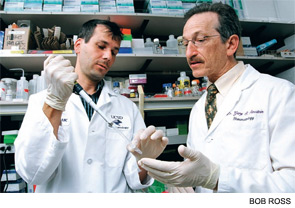Studies recently published in Arthritis & Rheumatism show that a key chemical produced by the central nervous system (CNS) decreases inflammation and suppresses production of proteins known to play a role in rheumatoid arthritis (RA).1-2 This opens the way for developing a novel class of drugs that mimic this effect of the CNS on RA.
The project—led by Gary S. Firestein, MD, professor of medicine and chief of the division of rheumatology, allergy, and immunology at the University of California, San Diego—was funded by an ACR Research and Education Foundation (REF)
Within Our Reach: Finding a Cure for Rheumatoid Arthritis research grant. Dr. Firestein and his team performed several studies beginning with the observation of a key enzyme in the spinal cord called p38 MAP kinase that is activated by joint inflammation. They found that, surprisingly, blocking this enzyme in the CNS dramatically decreased joint damage in a model of RA.

The subsequent experiments focused on unraveling the pathways that led from the spinal cord out to the joint and suppressed inflammation. These studies showed that the vagus nerve—which helps control heart rate, digestion, and many other body functions—is activated when p38 MAP kinase is blocked. Therefore, the researchers hypothesized that vagus nerve stimulation could be an important antiinflammatory mechanism.
“To test our hypothesis, we showed that bypassing the nerve and artificially increasing acetylcholine—which is the chemical released by the vagus nerve—suppresses joint inflammation. Finally, we showed that stimulation of one specific acetylcholine receptor, known as the alpha7 nicotinic receptor, could decrease production of inflammatory mediators by the cells that line the joint,” says Dr. Firestein.
Thus, these experiments into the fundamental biology of the CNS led to a specific receptor that can potentially mimic the reaction of the CNS to joint inflammation. Alpha7 receptor–specific compounds are already being tested for conditions like Alzheimer’s disease, and could be available for testing in RA. “By characterizing the antiinflammatory activities of these compounds, we hope that we have stimulated development of this novel class of drugs for rheumatoid arthritis,” says Dr. Firestein.
Apply Now
The REF is now accepting applications for the fourth round of Within Our Reach–funded RA grants. Applications are due December 1. Visit www.rheumatology.org/REF for more
The Within Our Reach campaign, launched in 2006, is the largest private fundraising campaign in the REF’s history. It will tap a diverse donor base and raise $30 million to accelerate the innovative research necessary to find a cure for RA. The campaign has received tremendous support from the pharmaceutical industry, biotech companies, physicians, and patients, raising $26 million to date. To learn more about the campaign, visit www.WithinOurReach.info.
References
- Waldburger JM, Boyle DL, Pavlov VA, Tracey KJ, Firestein GS. Acetylcholine regulation of synoviocyte cytokine expression by the a7 nicotinic receptor. Arthritis Rheum. 2008;58:3439-3449.
- Waldburger JM, Boyle DL, Edgar M, et al. Spinal p38 MAP kinase regulates peripheral cholinergic outflow. Arthritis Rheum. 2008;58:2919-2921.